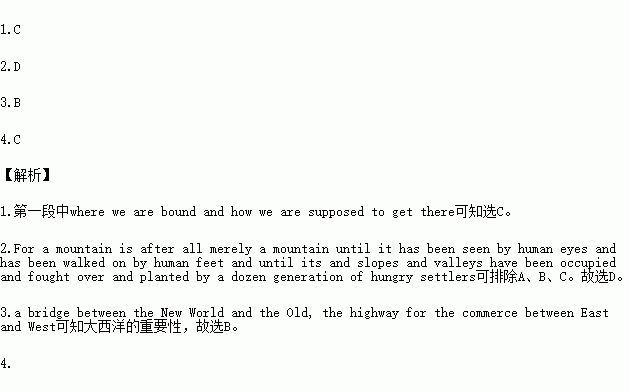题目内容
E
Before we start a voyage, we usually try to find out more or less definitely where we are bound and how we are supposed to get there.
I happen to have the “Concise Oxford dictionary” on my desk and that will do as well as any other. The word I am looking for appears at the bottom of Page 344. edition 1912.
“Geography: the science of the earth's surface, form, physical features, natural and political divisions, climate, productions and population.”
I could not possibly hope to do better, but I still stress some of the aspects of the case at the expenses of others, because I intend to place man in the centre of the stage. This book of mine will not merely discuss the surface of the earth and its physical features, together with its political and natural boundaries. I would rather call it a study of man in search of food and shelter and leisure for himself and for his family and an attempt to his background or has reshaped his physical surroundings in order to be comfortable and well nourished and happy with his limited strength.
Among the two million human beings in the world, there is of course the widest possible range for all sorts of experiments of an economic and social and cultural nature. It seems me that those experiments deserve our attention before anything else. For a mountain is after all merely a mountain until it has been seen by human eyes and has been walked on by human feet and until its and slopes and valleys have been occupied and fought over and planted by a dozen generation of hungry settlers.
The Atlantic Ocean was just as wide and deep and as wet and salty before the beginning of the 13th century as after, but it took the human touch to make it what it is today—a bridge between the New World and the Old, the highway for the commerce between East and West.
For thousands of years the endless Russian plains lay ready to offer their abundant harvest to whoever should take the trouble to sow the first grain. But the aspect of that country today would he a very different one if the hand of a German or a Frank, rather than that of a Slav, had guided the iron-pointed stick that plowed the first furrows (犁沟).
The island of Nippon would shake and quake just as continually, whether they happened to be settled by Japanese or by the Tasmanian race, but in the latter case they would hardly be able to feed 60,000,000 people.
Generally speaking, I have paid more attention to the purely “human” side of geography than to the commercial problems which are so important in a day and age devoted to mass production.
1.In the first four paragraphs, the author wants to share with the readers ______.
A. his approach to planning a voyage
B. his emphasis on using a dictionary
C. his definition of the word “geography”
D. his altitude to the earth's physical features
2.Which of the following will the author NOT consider to be on experiment according to Paragraph 5?
A. Exploring a mountain.
B. Climbing a mountain.
C. Planting on slopes and valleys.
D. Becoming hungry.
3.Which of the following is implied about the Atlantic Ocean?
A. It is wide, deep, wet and salty.
B. Human touch makes it important.
C. There is a bridge over it.
D. The highway is busy there.
4.The author mentioned the Russian plains and the island of Nippon to show that _____.
A. they both feed a lot of people
B. they enjoy very good natural conditions
C. different people may make the same place different
D. their natural conditions haven't changed for many years
书面表达
随着中国经济的发展,私家车日渐增多,很多学生上学都有车接送,为此,同学之间观点不一。请你根据下表中双方不同观点用英语写一篇文章给上海英文星报--Shanghai Star ,介绍这种情况及你对这一现象的看法。
支持 | 反对 |
1.省时、方便; 2.安全。 | 1.拥堵、车祸; 2.易相互攀比。 |
你的看法…… | |
注意:
1. 可适当增加细节,以使行文连贯;
2. 词数100左右;
3.文章开头已为你写好,不计入总词数。
参考词汇:攀比 vie with …
书面表达
In recent years, more and more students go to school in private cars. People have different opinions about this phenomenon.


